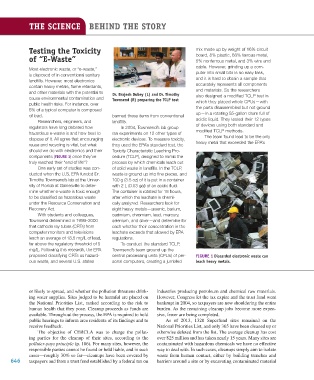Page 647 - Environment: The Science Behind the Stories
P. 647
THE SCIENCE BEHIND THE STORY
Testing the Toxicity mix made up by weight of 16% circuit
of “E-Waste” board, 8% plastic, 68% ferrous metal,
5% nonferrous metal, and 3% wire and
cable. However, grinding up a com-
Most electronic waste, or “e-waste,”
is disposed of in conventional sanitary puter into small bits is no easy task,
landfills. However, most electronics and it is hard to obtain a sample that
contain heavy metals, flame retardants, accurately represents all components
and other materials with the potential to Dr. Brajesh Dubey (L) and Dr. Timothy and materials. So the researchers
cause environmental contamination and Townsend (R) preparing the TCLP test also designed a modified TCLP test in
public health risks. For instance, over which they placed whole CPUs—with
6% of a typical computer is composed the parts disassembled but not ground
of lead. banned these items from conventional up—in a rotating 55-gallon drum full of
Researchers, engineers, and landfills. acidic liquid. They tested their 12 types
regulators have long debated how In 2004, Townsend’s lab group of devices using both standard and
hazardous e-waste is and how best to ran experiments on 12 other types of modified TCLP methods.
dispose of it. All agree that encouraging electronic devices. To measure toxicity, The team found lead to be the only
reuse and recycling is vital, but what they used the EPA’s standard test, the heavy metal that exceeded the EPA’s
should we do with electronics and their Toxicity Characteristic Leaching Pro-
components (FIGURE 1) once they’ve cedure (TCLP), designed to mimic the
truly reached their “end of life”? process by which chemicals leach out
One early set of studies was con- of solid waste in landfills. In the TCLP,
ducted when the U.S. EPA funded Dr. waste is ground up into fine pieces, and
Timothy Townsend’s lab at the Univer- 100 g (3.5 oz) of it is put in a container
sity of Florida at Gainesville to deter- with 2 L (0.53 gal) of an acidic fluid.
mine whether e-waste is toxic enough The container is rotated for 18 hours,
to be classified as hazardous waste after which the leachate is chemi-
under the Resource Conservation and cally analyzed. Researchers look for
Recovery Act. eight heavy metals—arsenic, barium,
With students and colleagues, cadmium, chromium, lead, mercury,
Townsend determined in 1999–2000 selenium, and silver—and determine for
that cathode ray tubes (CRTs) from each whether their concentration in the
computer monitors and televisions leachate exceeds that allowed by EPA
leach an average of 18.5 mg/L of lead, regulations.
far above the regulatory threshold of 5 To conduct the standard TCLP,
mg/L. Following this research, the EPA Townsend’s team ground up the
proposed classifying CRTs as hazard- central processing units (CPUs) of per- FIGURE 1 Discarded electronic waste can
ous waste, and several U.S. states sonal computers, creating a jumbled leach heavy metals.
or likely to spread, and whether the pollution threatens drink- industries producing petroleum and chemical raw materials.
ing water supplies. Sites judged to be harmful are placed on However, Congress let the tax expire and the trust fund went
the National Priorities List, ranked according to the risk to bankrupt in 2004, so taxpayers are now shouldering the entire
human health that they pose. Cleanup proceeds as funds are burden. As the remaining cleanup jobs become more expen-
available. Throughout the process, the EPA is required to hold sive, fewer are being completed.
public hearings to inform area residents of its findings and to As of 2013, 1320 Superfund sites remained on the
receive feedback. National Priorities List, and only 365 have been cleaned up or
The objective of CERCLA was to charge the pollut- otherwise deleted from the list. The average cleanup has cost
ing parties for the cleanup of their sites, according to the over $25 million and has taken nearly 15 years. Many sites are
polluter-pays principle (p. 186). For many sites, however, the contaminated with hazardous chemicals we have no effective
responsible parties cannot be found or held liable, and in such way to deal with. In such cases, cleanups simply aim to isolate
cases—roughly 30% so far—cleanups have been covered by waste from human contact, either by building trenches and
646 taxpayers and from a trust fund established by a federal tax on barriers around a site or by excavating contaminated material
M22_WITH7428_05_SE_C22.indd 646 13/12/14 2:25 PM

